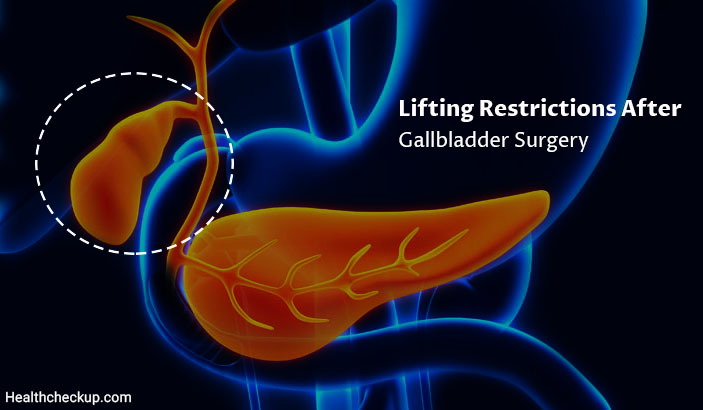The gallbladder is an organ which stores bile and releases into the gastrointestinal tract through the biliary ducts after meals. Bile is important in effective digestion of fat in our meals and the absorption of fat-soluble vitamins like vitamin A, D, E and K. Since the gallbladder is not involved in bile synthesis it is not a vital organ which should be preserved in the human body. There are many indications for the removal of the gallbladder. The standard medical term for this surgery is cholecystectomy.
Symptomatic gallbladder stone disease is the most common indication for cholecystectomy. Other reasons include gallbladder tumor and infection. The surgery can be performed as a minimally invasive laparoscopic method or as open surgery. The expected post-operative recovery time is significantly shorter in the laparoscopic approach. The patients to be discharged receive a set of advice to be followed postoperatively and lifting restrictions after gallbladder surgery is one of the most focused areas in it.
Lifting Restrictions After Gallbladder Surgery
- Generally, the patient is advised to increase their activities slowly. On the first post-operative day onwards, the patient is expected to get up from the bed and walk every hour to prevent blood clot formation. Since the patients who undergo laparoscopic surgery take a shorter duration for their recovery as mentioned in the first paragraph, they may get discharged from the hospital on the day after the surgery if no post-operative complication occurred. The time taken to return to normal activities will depend on each patient body’s healing power.
- Patients should refrain from lifting any weight greater than 5-10 pounds at least for 2 -4 weeks. This includes strenuous activities such as vacuuming, cycling, jogging, mowing lawns, moving furniture, aerobic exercises, lifting children, heavy groceries, laundries, backpacks and etc. Also avoid pushing, pulling or abdominal pressure for these first 4 weeks. Since coughing can increase the abdominal pressure and affect the wound healing, when coughing, the patient is advised to place a pillow over the incision and gently press inward to reduce the pressure (from coughing) on their incision.
- Driving should be avoided for first 4-7 days postoperatively while the patient is on pain-relieving narcotic medications or at least until the first follow up visit. They must not drive heavy vehicles like lorries, trucks, containers at least for 4 weeks, because they are considered as strenuous activities. But there are no restrictions in riding as a passenger if they are able to sit comfortably for a long period of time.
- Patients can gradually increase the distance of walking, up to a level that is best tolerated and they may climb stairs in moderation.
- They can report to their jobs one week after a laparoscopic surgery if it involves clerical work and no heavy work. If it is an open surgery, they can report only after 2 weeks.
- For patients who were sexually active before the surgery, may return to their sexual activities 2 weeks after the cholecystectomy on average.
Even though these lifting restrictions after gallbladder surgery have been identified as beneficial for the patient any pain on the right side after surgery should be noted by the patient and medical care should be seeked promptly. Because postoperative pain on the right side may be a sign of complication associated with the surgery such as damage to a bile duct, internal bleeding or surgical site infection. If patients develop any significant abdominal pain while returning to strenuous activities, they should report back to the hospital as soon as possible.
If the patient develops a pain at the surgical incision site, it could be a sign of infection. Infected surgical scars should be treated accordingly because it can increase the chances of developing incisional hernia after gallbladder surgery. The infection leads to weakening of the scar and the abdominal contents can herniate through it, some years after the surgery. These hernias need to be corrected early because they are at high risk of getting obstructed. Since the time taken for the healing is longer in open surgeries, surgical site infections are commoner in open surgeries than in laparoscopic ones. The risk of developing hernia after gallbladder surgery is also commoner in open surgeries than in laparoscopic surgeries.
The lifting restrictions after gallbladder surgery have proven benefits in improving the patient’s recovery time and the quality of life afterward. Adhering to these restrictions has shown to reduce the chances of hernia occurring after gallbladder surgery effectively. Unnecessary fear of returning back to the normal lives in patients who are undergoing gallbladder surgery may sometimes interfere with consent taking for the surgery also. Therefore patients should be properly educated regarding lifting restrictions after gallbladder surgery prior to the operation.
Dr. Chauturi is an experienced writer specializing in English language and Medical Sciences, and degree holder in Medicine, Bachelor of Surgery at University of Sri Jayewardenepura currently awaiting her internship.









